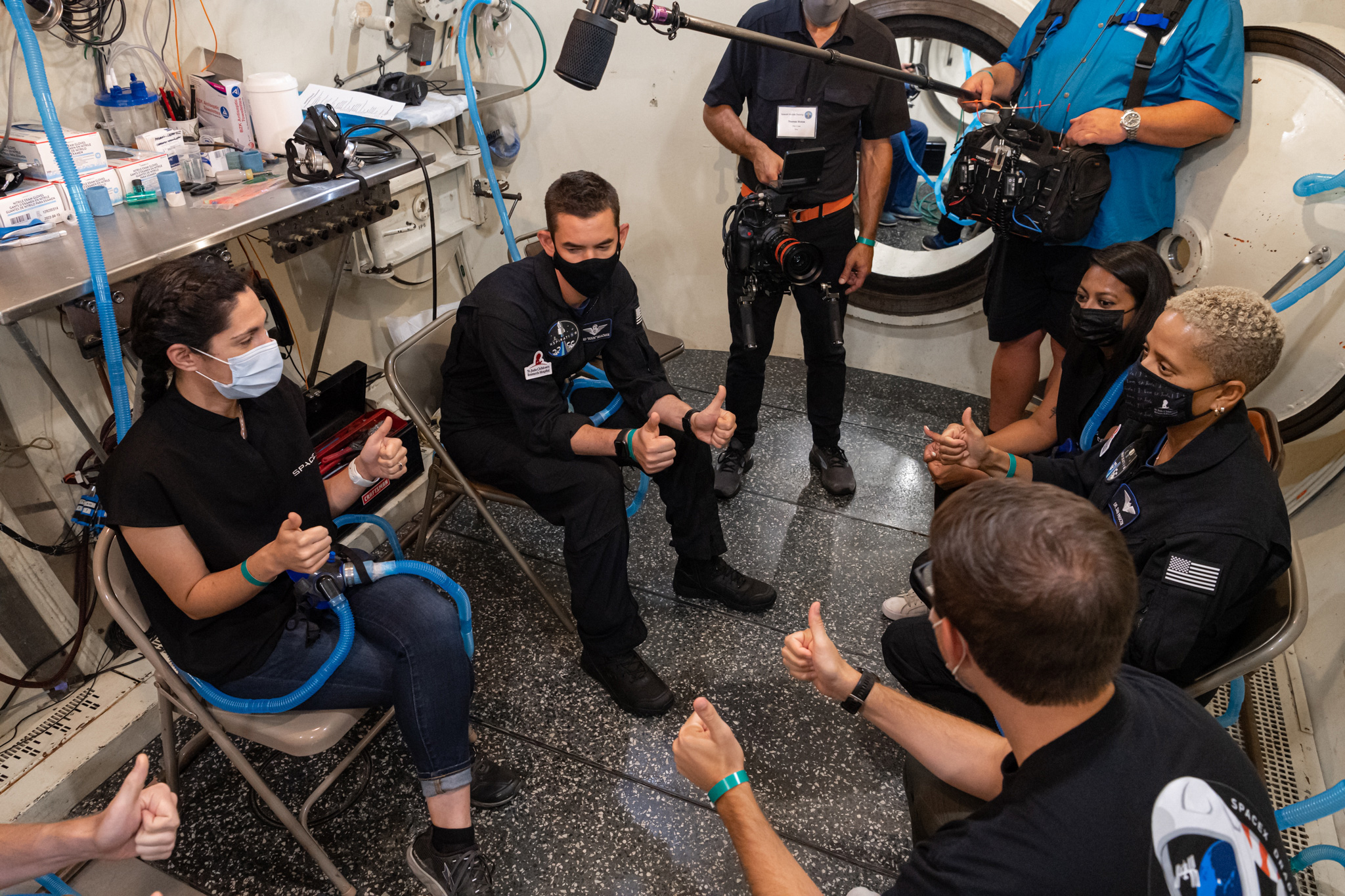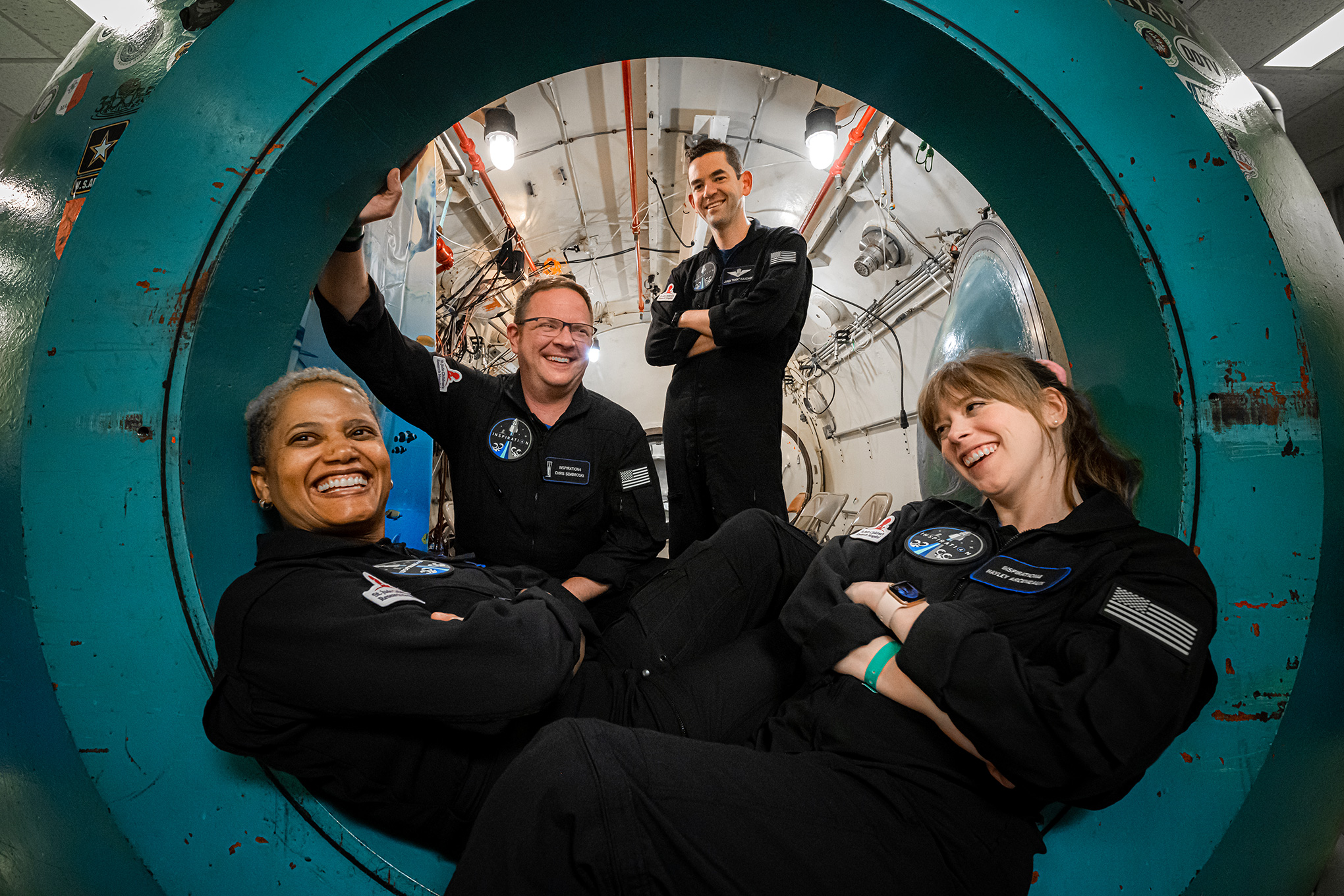TIME Studios is producing the Netflix documentary series Countdown: Inspiration 4 Mission to Space, starting Sept. 6.
If you want to go to space, Inspiration4 commander Jared Issacman believes, it helps to climb a mountain first, in order to bond as a group over a shared physical struggle. Any mountain will do, really, but for the crew of Inspiration4—the first all-civilian team bound for orbital space, set to fly aboard a SpaceX Crew Dragon spacecraft next month—it was Mt. Rainier, the 14,100-ft. volcanic peak in western Washington State.
“I wanted them to get comfortable with being uncomfortable,” says Isaacman, 39, “because not everything about space will be comfortable.”
If that’s what he wanted, that’s what he got. There was the cloud bank that followed the crew the entire way up their trek to their target spot at the 10,000-ft. elevation point on the flank of the mountain. There was the cutting cold and the blowing snow and the frozen ham and cheese sandwiches that greeted them when they opened their packs. And there was the constant plodding over the course of their two-night, three-day stay as well.

“My legs were on fire,” says Chris Sembroski, 41, an aerospace engineer at Lockheed Martin in Everett, Washington in everyday life and the payload specialist for Inspiration4. “I just had to keep breathing.”
In the six decades that human beings have been flying in space, climbing a mountain has never been on the astronaut training must-do checklist. But in the six decades human beings have been flying in space, there’s never been a mission exactly like Inspiration4. The brainchild of Isaacman, the billionaire CEO of online payment company Shift4 Payments, the mission is equal parts an act of charity (an effort to raise awareness and funds for St. Jude Children’s Research Hospital in Memphis, Tenn) and an act of audacity (an attempt to democratize space, to prove that leaving the planet is an experience that ought to be and can be available to more than just professional astronauts). Isaacman purchased all four seats aboard the Crew Dragon for an undisclosed sum, and chose his three crewmates, who besides Sembroski also include Sian Proctor, 51, a professor of geosciences at South Mountain Community College in Phoenix, Arizona and Hayley Arceneaux, 30, a childhood cancer survivor and a physicians’ assistant at St. Jude.
From the start, the group’s training differed radically from that of any crew before them, and not just because they are so eclectic a band of all-civilian astronauts. There is also the compressed time frame. NASA typically takes two years or more to train a crew for a particular mission—not to mention the preceding years astronauts spend in basic training before they qualify for a given mission in the first place. The Inspiration4 crew, by contrast, got word of their selection in February, began training in early April, and are set to fly in September.
“I’m learning how to be a system’s engineer in four months,” says Proctor. “And I’m not an engineer.”

To make that schedule work, the crew got thrown into the deep end early, beginning their work making centrifuge runs at the National Aerospace Training and Research Center in Southampton, Pa. The SpaceX trainers sought as much verisimilitude as they could during those sessions, piping the sounds of liftoff, reentry and splashdown into the centrifuge chamber and spinning the apparatus up to the four-to-six g’s the crew will actually feel at each of those points in the flight profile. They even included the thud and rocking that they’ll experience after they hit the ocean following reentry.
The centrifuge can accommodate just one person at a time, and that helped shape the course of their training. “They kept each one of us who had completed the run separated from the ones who had not gone through it yet,” says Isaacman. “That way we couldn’t tell them what to expect.”
Other parts of the crew’s training regimen include 60-hour, week-long sessions at SpaceX headquarters in Hawthorne, Calif., where they alternate their time between simulator training and classroom work. A July morning session began with nothing more glamorous than learning how to open and close the Dragon’s forward hatch while taking care to protect the rubber seals which ring the hatch and keep it airtight from damage by dust or grit, which could lead to a deadly pressure leak. When open, the hatch must be draped with the equivalent of a sort of fitted bed sheet—decidedly low tech, albeit with a decidedly high purpose.
“Nothing all that fancy about it,” Sembroski said, as he nevertheless rehearsed and re-rehearsed draping the protective fabric just so.
For the rest of the morning, the crew familiarized themselves with the cupola—a domed window that was designed specifically for the Inspiration4 mission and is being retrofitted to the nose of the spacecraft, to maximize the viewing and photography opportunities the astronauts will have during their three days in orbit. Here too, the session seemed deceptively simple at first—learning to do nothing more than look out a window. Except that this is a three-layer, air-tight window that separates the crew from the vacuum of external space and that is capable, at least in the event of an anomaly, of structural failure. That required the crew to practice sealing the hatch that separates the cockpit from the cupola viewing station within 30 seconds. Such an accident is highly unlikely: SpaceX tested the cupola at twice the air pressure it will experience in space and at extreme temperatures mimicking the extreme heat of the daylight side of Earth and the extreme cold soak of the dark side. Still, the crew practiced in case it failed all the same.
More of that day’s training included detailed classroom instruction on splashdown and recovery—including how to deal with such unlikely emergencies as the spacecraft springing a link and beginning to sink, or toxic thruster exhaust filling the cockpit. All of that was before a 1 p.m. lunch break.
“Training is my full time job now,” says Arceneaux.
The crew members spend 60-hour weeks training away from SpaceX, too, immersing themselves in thick briefing books and learning their particular assignments aboard the spacecraft. As Commander, Isaacman will be responsible for all communications with ground controllers and overseeing the overall operation of the spacecraft. Proctor, as Pilot, will execute the commands Isaacman issues and will assume the commander’s responsibilities if he is busy with an emergency or other unforeseen development. Sembroski, as Payload Specialist, will see to conducting experiments as well as to stowage and placement of essential equipment—no small matter, since the spacecraft must be kept exquisitely balanced, especially for reentry (meaning that if, say, water is consumed from a supply cabinet on one side of the spacecraft the remaining weight in the spacecraft must be re-shifted to restore equilibrium). Arceneaux will serve as Chief Medical Officer, tending to the physical needs of the crew and running some of the experiments they will carry aloft. A single recent homework assignment Isaacman sent the crew ran more than six pages and over 2,000 words.

“And on top of everything else,” says Proctor, “there’s also the fitness regimen—working out regularly to be ready for the physical demands of space.”
The crew members admit they’re not quite there yet. Plenty of 10-hour days and 60-hour weeks lie ahead before they’ll leave the planet. But they have about a month and a half before their launch to keep training, and like the nearly 600 humans who have preceded them into space, they’re learning that even before they depart the Earth they already carry some of the shimmer of star travelers.
“We visited space camp recently and everyone kept referring to us as ‘the astronauts,'” says Arceneaux. “I thought, ‘How the heck did this happen? A few months ago I was just ‘Hayley the physicians’ assistant.'” Come September, that humbler past—for the entire crew—will be changed for good and all.
TIME Studios is producing the Netflix documentary series Countdown: Inspiration 4 Mission to Space, starting Sept. 6.
Read More About the Inspiration4 Mission:
- Cybersecurity Experts Are Sounding the Alarm on DOGE
- Meet the 2025 Women of the Year
- The Harsh Truth About Disability Inclusion
- Why Do More Young Adults Have Cancer?
- Colman Domingo Leads With Radical Love
- How to Get Better at Doing Things Alone
- Michelle Zauner Stares Down the Darkness